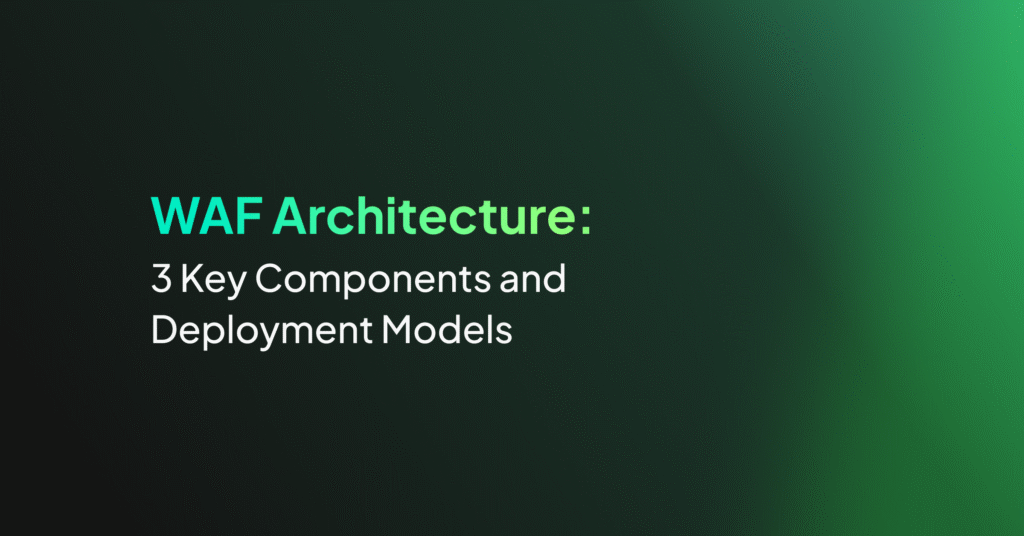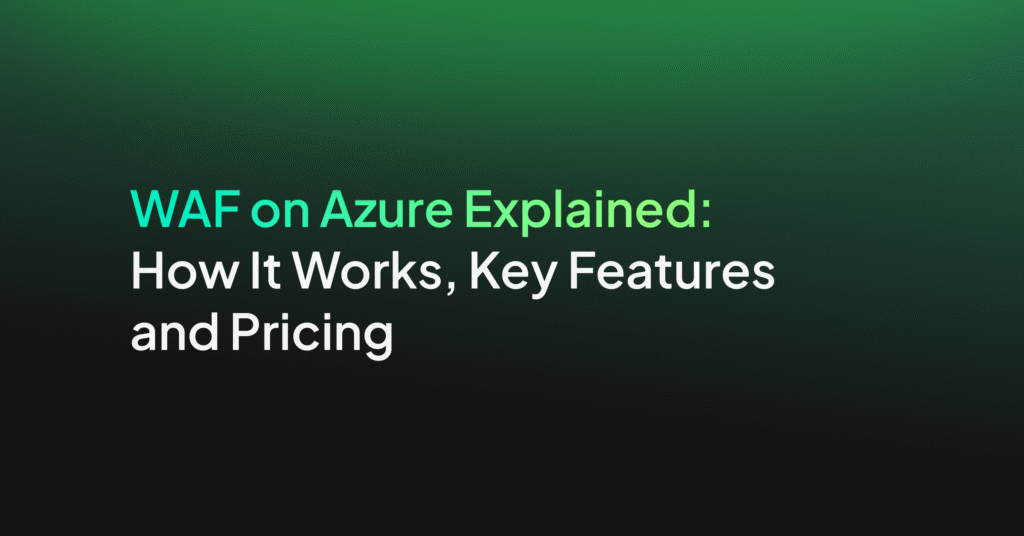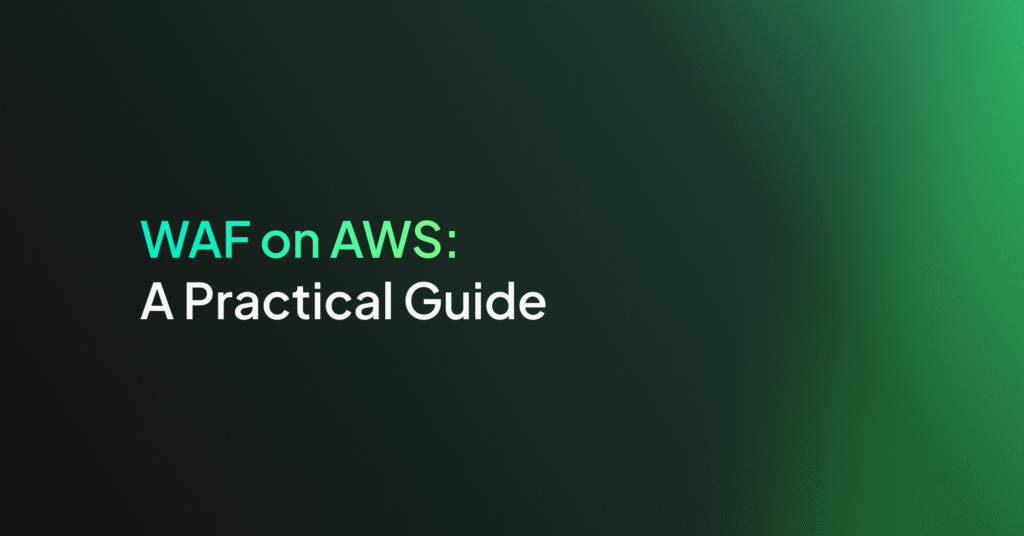Complete Guide to Web Application Firewalls for 2024

Why Is a WAF Important?
Web application firewalls serve as a defensive barrier, positioned between the web application and the Internet, to inspect incoming traffic for malicious patterns or attack vectors. This is particularly important as web applications become increasingly complex and are often exposed to cyber attacks designed to exploit vulnerabilities within the application’s code.
WAFs also help in maintaining an organization’s compliance with industry regulations and standards that mandate data protection and cybersecurity measures. By providing detailed logs and reports on traffic and threats, they aid in forensic analysis and ensure that sensitive data transmitted through web applications remains secure against unauthorized access or breaches.
WAF Architecture: How Does a WAF Work?
A web application firewall operates by inspecting and filtering HTTP/S requests before they reach the web application. It uses a set of predefined or dynamically learned rules to analyze the traffic for malicious content or patterns indicative of an attack.
When a request is deemed suspicious or dangerous based on these rules, the WAF can block it, allowing only legitimate traffic to pass through. This helps in mitigating potential threats before they can exploit vulnerabilities in the application.
Modern WAFs can also perform deep inspection of inbound and outbound content. They ensure that sensitive data does not leave the application in an unauthorized manner. By applying techniques such as SSL/TLS decryption, WAFs can scrutinize encrypted traffic, helping maintain the confidentiality and integrity of data transmissions.
Learn more in our detailed guide to WAF architecture (coming soon)
WAF vs. IPS vs. NGFW: What Is the Difference?
While all related to network security, these solutions have distinct roles.
WAFs focus on protecting web applications by inspecting HTTP/S traffic and identifying application-layer attacks.
Intrusion Prevention System (IPS) devices monitor network traffic to prevent vulnerability exploits regardless of the application. They operate primarily on the network layer, analyzing packets to detect and block attacks before they reach their targets.
Next-Generation Firewalls (NGFWs) combine the functionalities of traditional firewalls with additional features like IPS and sometimes WAF capabilities. They provide a more comprehensive security approach by enforcing policy-based controls. They offer intrusion prevention and advanced inspection for inbound and outbound traffic across multiple layers of the OSI model.
Related content: Read our guide to WAF vs Firewall (coming soon)
Types of WAFs
Web application firewalls can be network-based, host-based, or cloud-based.
Network-Based WAF
Network-based WAFs are deployed in-line at the network perimeter to protect the network’s web applications. This allows them to inspect all incoming and outgoing application traffic before it reaches the server or leaves the network. These WAFs offer high performance and low latency, making them suitable for environments that require speed and availability.
They achieve this with specialized hardware that can process large volumes of traffic without significantly impacting the response time or overall user experience. However, the deployment and maintenance of network-based WAFs require significant investment in infrastructure and expertise, making them more suited for large organizations with substantial IT resources.
Host-Based WAF
Host-based WAFs are integrated into the web application’s hosting environment, offering a more customizable and cost-effective security solution. They run on the same server as the application, providing less network latency and the ability to tailor security rules to the needs of each application.
This integration allows for a deeper inspection of traffic and more granular control over the application’s responses to threats. However, running a host-based WAF requires additional resources from the host server, which can impact the performance of the web application if not managed properly. It also requires security expertise to configure and update rules.
Cloud-Based WAF
Cloud-based WAFs offer a scalable security solution by providing protection as a service. This model eliminates the need for physical hardware or software installation, as the protection is applied remotely over the Internet. These WAFs easily integrate with existing applications, deploying security measures without significant upfront costs or complex configurations.
By leveraging global threat intelligence networks, cloud-based WAFs can quickly adapt to new threats and automatically update security policies across all protected applications. This ensures continuous protection against emerging vulnerabilities and attacks with minimal administrative overhead.
WAF Features and Capabilities
Web application firewalls typically offer the following capabilities:
- Attack signature databases: Repositories of known attack patterns and vulnerabilities. They enable WAFs to identify and block potential threats by comparing incoming traffic against a collection of signatures.
- AI-powered traffic pattern analysis: Uses machine learning algorithms to identify and respond to anomalous traffic patterns that might indicate a security threat. This allows WAFs to go beyond static rule sets and adapt dynamically to new attacks.
- Application profiling: Involves creating detailed profiles of web applications’ normal behavior. By understanding the typical patterns of legitimate traffic, including expected request formats, valid input types, and normal user behavior, WAFs can more accurately identify anomalies that may indicate a security threat.
- DDoS protection: Protects web applications from Distributed Denial of Service (DDoS) attacks, which overwhelm servers with traffic to disrupt service. WAFs mitigate these attacks by distinguishing between legitimate user traffic and malicious requests, using rate limiting and IP reputation analysis to block or throttle harmful traffic.
- Content Delivery Network (CDN): Distributes web content across multiple geographic locations to reduce latency and improve user experience. By caching content closer to end-users, CDNs can offload traffic from the origin server, minimizing the risk of DDoS attacks overwhelming the infrastructure.
WAF Security Models
Web application firewalls work by either allowing or denying web traffic.
Allowlisting
The WAF specifies a list of trusted entities, such as IP addresses, URLs, or query parameters, that are allowed to interact with a web application. This approach assumes that anything not explicitly permitted is potentially harmful and should be blocked. Allowlisting helps minimize the attack surface, allowing only known safe interactions, though it requires continuous updates and has the potential for over-restriction.
Denylisting
The WAF identifies and blocks traffic based on known malicious sources, IP addresses, URLs, or patterns. This method restricts access from entities deemed dangerous, preventing them from exploiting vulnerabilities. By maintaining a list of disallowed sources and characteristics associated with cyber threats, WAFs can respond quickly to attacks, although they may not cover zero-day exploits or previously unidentified attackers.
Hybrid Approach
The hybrid approach combines allowlisting and denylisting strategies to offer a balanced and adaptive security posture. By integrating the proactive control of allowlists with the reactive defense mechanisms denylists, the WAF provides protection against known threats while allowing legitimate traffic. This helps keep applications secure as new vulnerabilities emerge.
With a hybrid approach, the WAF can dynamically adjust security measures based on real-time analysis of traffic patterns and threat intelligence. It allows for the fine-tuning of security policies to minimize false positives.
What Are WAF Rules and Policies?
WAF rules and policies specify how a web application firewall identifies and manages traffic, distinguishing between legitimate requests and potential threats.
Rules are specific conditions or patterns that traffic must meet to be considered safe or malicious. These include signatures of known attack vectors, such as SQL injection patterns or cross-site scripting (XSS) attempts, as well as anomalies in request sizes or frequencies that could indicate a DDoS attack.
Policies are sets of these rules, organized and applied in a manner to enforce the desired level of security for a web application. They dictate how incoming requests are inspected and what actions – allow, block, challenge, or log – should be taken based on the analysis.
Customizing WAF rules and policies is essential for adapting to the security requirements of each web application. This includes defining strict conditions for sensitive areas of an application while allowing more lenient access to public sections.
How to Choose WAF Solutions
Here are some things to consider when evaluating WAF offerings.
Analyze Performance Impact
When selecting a web application firewall, assess its impact on the performance of web applications. A WAF that introduces latency or reduces throughput can negatively affect user experience, leading to slow page loads and potentially driving users away.
To evaluate the performance overhead associated with a WAF, analyze how the WAF handles high traffic volumes and its ability to process complex security rules without degrading application responsiveness. Consider also the ability of the WAF solution to adapt to changing traffic patterns and application demands.
Review Accuracy and Effectiveness
Evaluate the WAF’s accuracy in identifying and mitigating threats. Consider the WAF’s ability to correctly distinguish between malicious and legitimate traffic, minimizing false positives that can disrupt user experience and false negatives that could allow threats to pass through. Check also the WAF’s ability to adapt to new threats over time, including zero-day vulnerabilities.
To gauge these aspects, look into independent benchmarking studies or customer testimonials that shed light on real-world performance. Consider the frequency and process of updating threat intelligence and vulnerability signatures.
Consider Scalability
Scalability determines how well the solution can accommodate the growth of your web applications and handle increasing traffic volumes. A scalable WAF should seamlessly expand its capacity to protect more applications or absorb higher traffic without significant manual intervention or degradation in performance.
It should be able to distribute traffic load across multiple instances and automatically adjust its resources based on demand. The WAF solution should offer centralized management, enabling administrators to easily apply updates and configurations universally, regardless of how many web applications are covered.
Regulatory Compliance
Many industries are subject to strict data protection and privacy regulations. A WAF should help meet these requirements by providing strong security measures that prevent unauthorized access to sensitive data. This includes compliance with standards such as the General Data Protection Regulation (GDPR) in Europe, the Health Insurance Portability and Accountability Act (HIPAA) in the United States, and other regional or sector-specific regulations.
Ensure that the WAF solution supports compliance to protect against data breaches and shield the organization from potential fines and legal repercussions associated with non-compliance.
It should also offer detailed logging and reporting capabilities to aid in audits and investigations.
Check for Integration Capabilities
Assess the WAF’s ability to integrate with existing infrastructure and security tools, including development, monitoring, and incident response platforms. Look for solutions that offer APIs for automation, support for common logging standards, and compatibility with SIEM systems to enable real-time analysis and alerting.
Additionally, consider the WAF’s ability to integrate with cloud services, CDN providers, and other third-party security solutions. This helps in creating a cohesive security posture across various components within the IT ecosystem.
Learn more in our detailed guide to WAF solutions (coming soon)
Coralogix WAF
Coralogix sets itself apart in observability with its modern architecture, enabling real-time insights into logs, metrics, and traces with built-in cost optimization. Coralogix’s straightforward pricing covers all its platform offerings including APM, RUM, SIEM, infrastructure monitoring and much more. With unparalleled support that features less than 1 minute response times and 1 hour resolution times, Coralogix is a leading choice for thousands of organizations across the globe.
Learn more about Coralogix WAF and CDN
See Additional Guides on Key Security Testing Topics
Together with our content partners, we have authored in-depth guides on several other topics that can also be useful as you explore the world of security testing.
Burp Suite
Authored by Pynt
- Burp Suite: Solution Overview, Tutorial, and Top 5 Alternatives
- 8 Burp Suite Alternatives and Competitors
- Burp Suite Tutorial: Intercepting, Modifying & Scanning HTTP Traffic
Application Security
Authored by CyCognito
- 7 Steps of Web Application Penetration Testing
- Application Security: Risks, Process and Technologies [2025 Guide]
- 7 Steps of Web Application Penetration Testing
Cloud Native Security
Authored by Tigera




